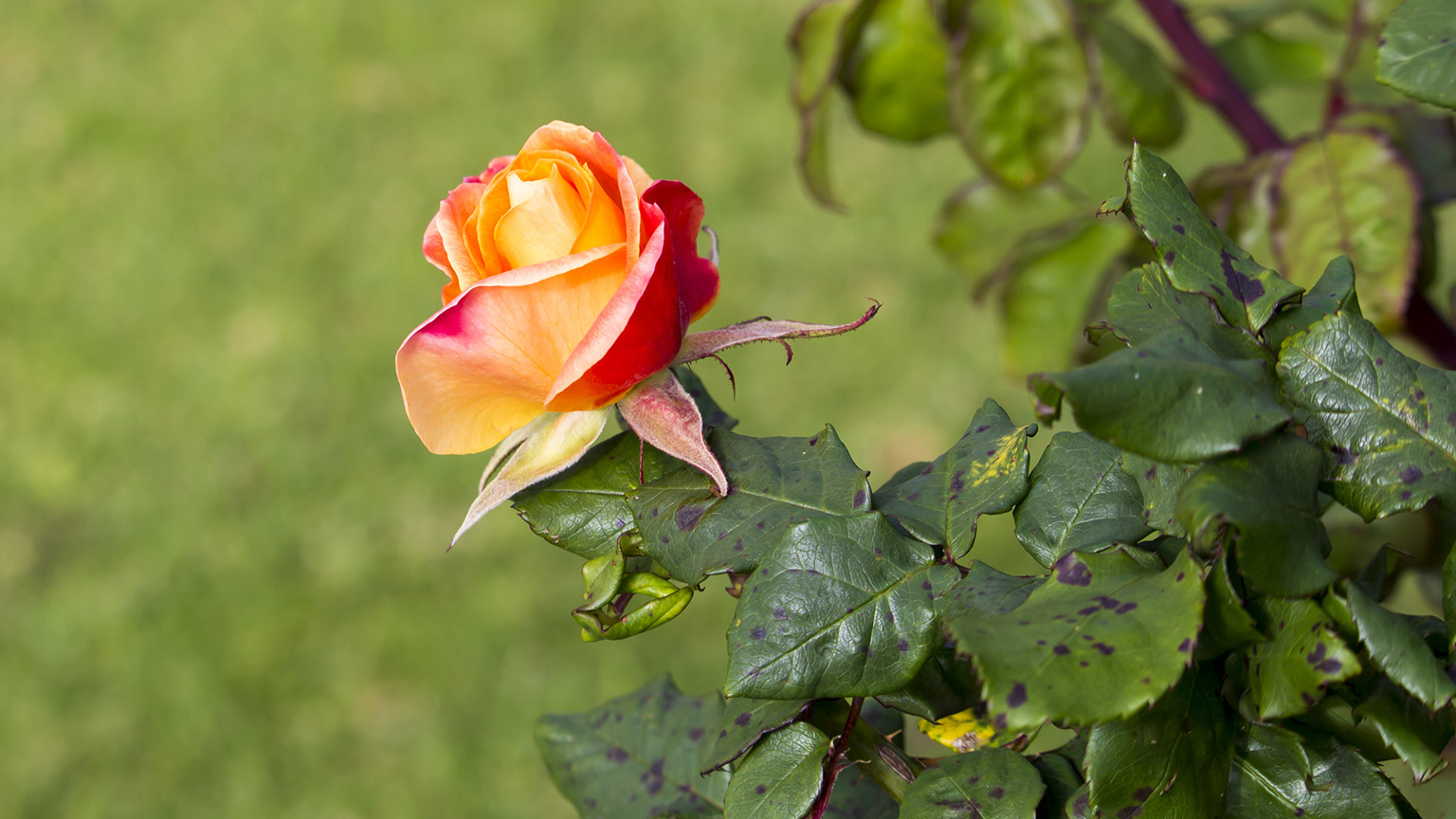Look closely at this rose (Rosa spp.). Can you see the black patches on its leaves? The gardener may suspect black spot - one of the most common rose fungal infections in New Zealand.
You may already know about microorganisms from previous studies. The following questions will give you a chance to refresh your memory. If you don't know the answers, select "show solution" and then study the questions so you are confident you have learned the material before learning about good microorganisms in the next section.
Activity – Microorganism basics
Feeling confident about microorganisms? Next up, we'll talk about the benefits and drawbacks of how they interact with plants.
As we know, there are a raft of beneficial (good) microorganisms in the soil, which contribute to the soil food web, such as rhizobacteria and mycorrhizal fungi.
Likewise above the surface there are a huge range of good microorganisms, such as:
- Endophytes: These are microorganisms that live within the tissues of plants without causing disease. They can help with nutrient uptake, disease resistance, and plant growth. See the image below.
- Epiphytic bacteria: These are bacteria that live on the surface of the leaves, stems, flowers, or fruit of plants. They can help with nutrient uptake, disease resistance, and plant growth.
- Yeasts: Some yeasts can live on the surface of plant tissues and help with nutrient absorption and disease resistance.
- Fungi: Some fungi can live on the surface of plants and help with nutrient absorption, disease resistance, and plant growth.
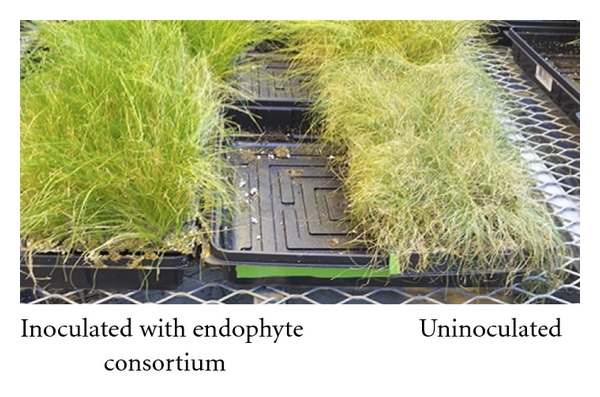
This image shows five-week-old perennial rye grass (Lolium perenne) responding to water stress. The uninoculated grasses look water stressed, whereas the inoculated grasses stayed greener longer.
Source: Wikimedia Commons
When we talk about “bad” microorganisms we are referring to those that cause harmful deviation from normal. These damaging microorganisms are referred to as pathogens (or causal agents) and the damage they cause is called a disease.
For a disease to occur, there must be a(n):
- susceptible host – in other words a plant that is able to be infected
- environment that is favourable for the development of the disease
- pathogen that is capable of replicating itself.
Likewise, if any of the above is prevented, the disease cannot occur.
Let’s take a look at our four common types of plant pathogens.
Expand the labels to learn about each of them. This is also a great study tool to help you memorise the information.
Fungi
As we’ve already discussed, certain fungi can be beneficial to plants, however, other types of fungi are associated with plant diseases. They are microscopic organisms that grow in or on plants and can cause a range of symptoms, such as wilting, leaf spots, and rotting.
Fungi are able to infect plants by penetrating the plant tissue and releasing enzymes that break down the plant cell walls. Once inside the plant, they can grow and spread, causing damage to the plant and sometimes leading to the death of the affected tissue or the entire plant.
Plant diseases caused by fungi can be difficult to manage, as fungi can produce spores that can survive in the soil or on plant debris for long periods of time, making it difficult to eliminate them completely.
Examples of fungi that have caused significant damage to plants in Aotearoa are:
| Disease | Fungus | Description | |
|---|---|---|---|
|
Kauri dieback
|
Phytophthora agathidicida |
The disease causes root rot, which leads to tree death, and is characterised by yellowing foliage, thinning crowns, and a white fungal growth under the bark. Kauri dieback is a significant threat to the survival of NZ's iconic kauri trees. |
 This Kauri tree is "bleeding" due to the fungal growth. |
| Myrtle rust | Austropuccinia psidii | Myrtle rust affects plants in the myrtle family, including pohutukawa, rata, and manuka trees, as well as feijoa and guava plants. Learn more |
 The Ministry for Primary industries asks for our help in looking out for myrtle rust in your garden, local parks, and other green areas. |
Bacteria
Bacteria are a group of microorganisms that can cause plant diseases. They are single-celled organisms that can enter plants through wounds, natural openings, or insect-feeding sites.
Once inside the plant, bacteria can reproduce and spread, causing a range of symptoms such as wilting, leaf spots, and cankers. Some bacteria can produce toxins that can also cause damage to the plant.
Plant diseases caused by bacteria can be difficult to manage, as bacteria can be present in soil, water, and plant debris, and can spread rapidly through irrigation and rain splashes.
Examples of bacteria that have caused significant damage to plants in Aotearoa are:
| Bacteria | Description | |
|---|---|---|
| Pseudomonas syringae pv. actinidiae (Psa) |
The causal agent of bacterial canker of kiwifruit, which was first identified in New Zealand in 2010. The disease can cause significant yield losses and has had a major impact on the New Zealand kiwifruit industry. |
 Psa infects the buds, leaves, and vines of kiwifruit plants, causing leaf spots, wilting, and cankers. |
| Xanthomonas campestris pv. campestris (Xcc) |
The causal agent of black rot of brassicas, which affects a range of crops including broccoli, cabbage, and cauliflower. The disease can cause significant yield losses and is a major concern for brassica growers in New Zealand. |
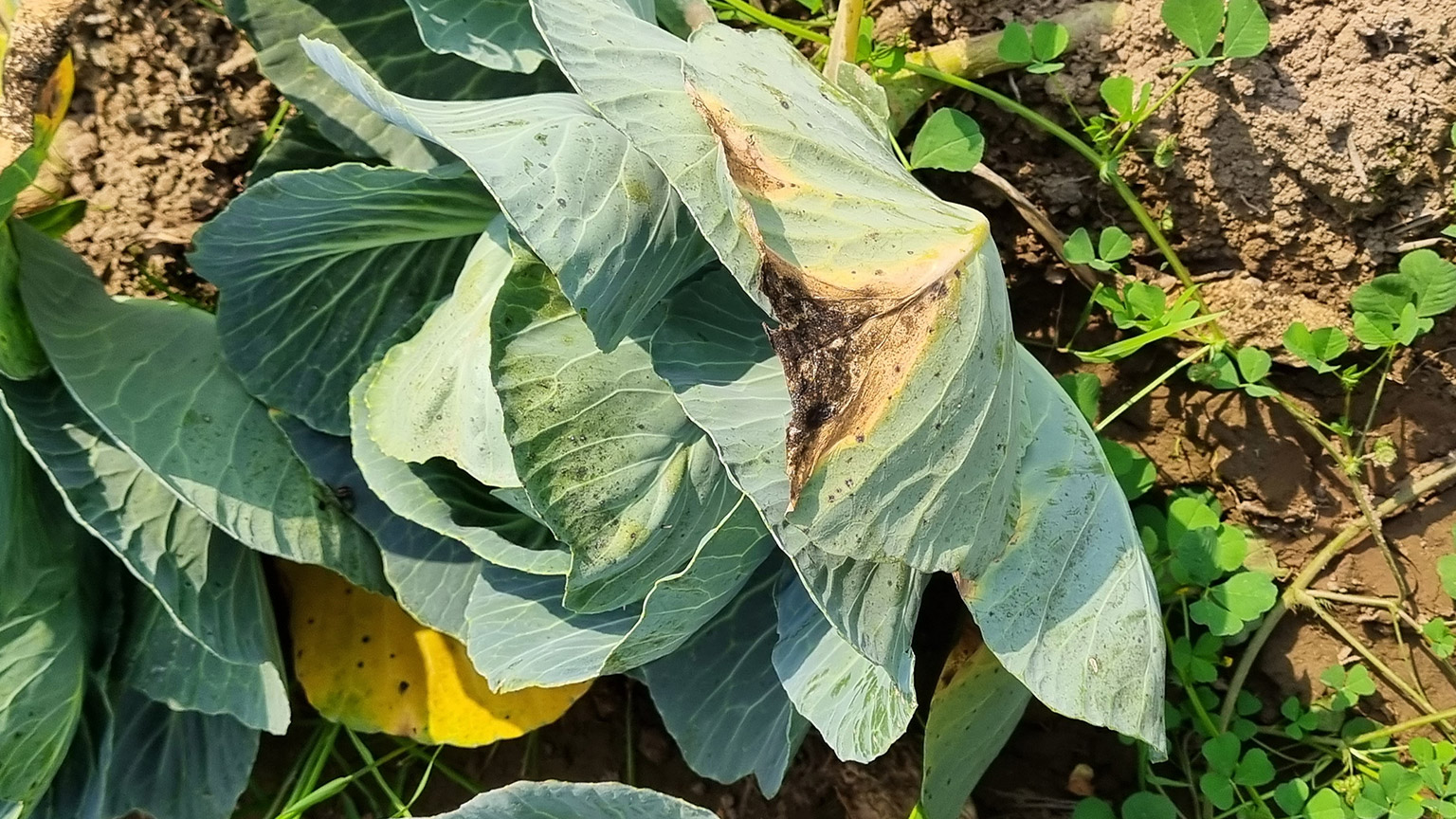 Xcc infects the leaves and stems of plants, causing yellowing, wilting, and dark, sunken lesions. |
Virus
A plant virus is a tiny infectious particle that can cause disease in plants. It consists of genetic material, such as RNA or DNA, surrounded by a protective protein coat. Viruses replicate by entering plant cells and “hijacking” the cell’s “machinery,” to create more virus particles.
When a plant is infected with a virus, the virus can disrupt the normal growth and development of the plant, causing symptoms such as stunted growth, yellowing of leaves, or distorted shapes.
Plant viruses can be spread from one plant to another through various means. Once a plant is infected with a virus, there is usually no cure, and the infected plant may need to be removed to prevent the spread of the virus to other plants.
| Cucumber mosaic virus | One example of a plant virus found in New Zealand is the cucumber mosaic virus (CMV), which can infect a wide variety of plants and is transmitted by aphids. Source: Wikimedia Commons |
Nematodes
These are a type of small, worm-like organisms that can cause plant diseases. Plant-parasitic nematodes are a diverse group of microscopic animals that can infect roots and other below-ground plant parts. They can cause significant damage to crops.
Plant-parasitic nematodes damage plants by feeding on plant cells, and in some cases, they can also transmit viruses or other pathogens to plants. Symptoms of nematode infestations may include stunted growth, reduced yields, and root galls or lesions. Management of nematode infestations can involve the use of chemical nematicides, crop rotation, and the use of resistant cultivars.
| Root-knot nematodes (Meloidogyne hapla) | In Aotearoa, they cause the formation of galls or knots on the roots of infected plants, leading to reduced plant growth and yield. | 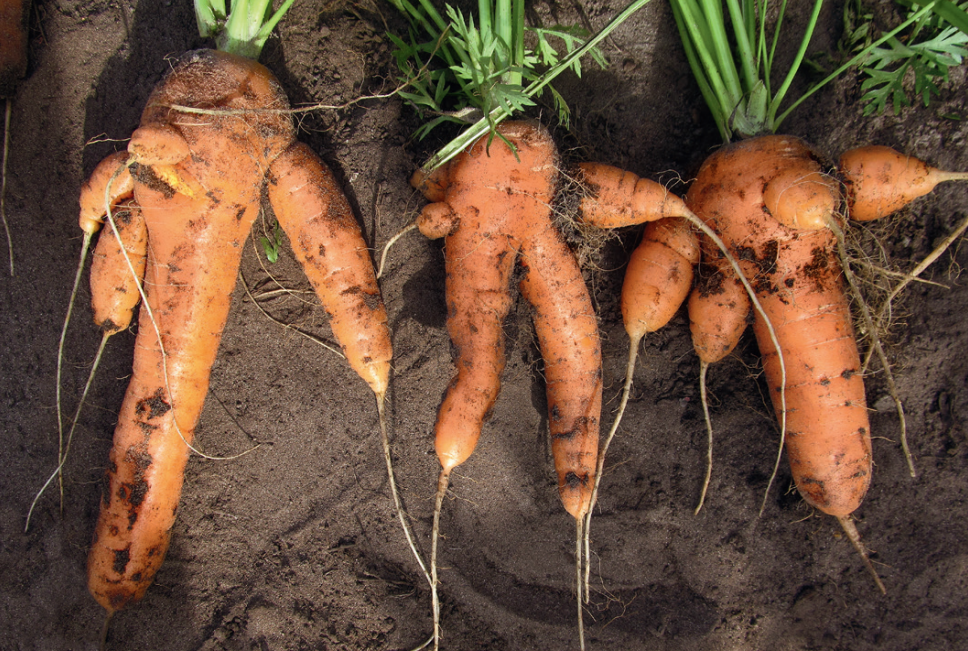 |
Now take a moment and consolidate your learning by answering questions about the impact of microorganisms on the plants you grow. Progression through the questions happens automatically, and you will find out if you are correct immediately.
Activity – The good and bad of microorganisms

These tomato plants (Solanum lycopersicum) have spread bacterial disease to each other. The result can be devastating for an entire crop.
Plant diseases can be spread in a variety of ways, including:
- Soilborne pathogens: Many plant diseases are caused by soilborne pathogens such as fungi, bacteria, and nematodes. These pathogens can persist in the soil for years, infecting plants that are planted in the same location.
- Airborne pathogens: Some plant diseases are spread by airborne pathogens such as fungi and bacteria. These pathogens can be spread by wind or by insects that feed on infected plants.
- Waterborne pathogens: Some plant diseases are spread through pathogens in rainwater or irrigation water which come into contact with plant leaves.
- Insect vectors: Some plant diseases are spread by insects that feed on infected plants and then transmit the pathogen to healthy plants. For example, aphids can transmit viruses to plants. The term insect vector means an insect that can transmit a disease-causing pathogen from one plant to another.
- Contaminated tools or equipment: Plant diseases can also be spread through contaminated tools or equipment, such as pruning shears or tillage equipment, which have come into contact with infected plants. See the pro tip below.
- Human activities: Plant diseases can also be spread through human activities, such as:
- when gardeners or farmers move infected plants or soil from one location to another
- when travellers bring traces of contaminated soil or plant material into the country
- when importers bring contaminated soil, plant material, or insect vectors into the country and the harmful organisms avoid being destroyed by biosecurity measures such as heat, or fumigation.
Pro tip: washing your tools
This video provides information about keeping your tools clean and resistant to rust. Rubbing alcohol is also called Isopropyl alcohol and can be purchased from big box stores, such as Mitre 10. Camelia oil is also readily available in New Zealand.
Preventing the spread of plant diseases
Preventing the spread of plant diseases often involves a combination of cultural practices, such as crop rotation, sanitation, and the use of disease-resistant plant varieties, as well as the use of chemical or biological controls when necessary.
While our focus is on preventing these pathogens from reaching our garden, and controlling them when they do, plant diseases can have a significant effect on Aotearoa’s biodiversity. For example, myrtle rust, which first arrived in Aotearoa by wind in 2017, is seriously impacting native trees such as pohutukawa and rata (Metrosideros spp.).
This article from Landscape News talks about how mātauranga Māori (Māori knowledge and wisdom) is helping to ensure these iconic plants won’t become extinct.
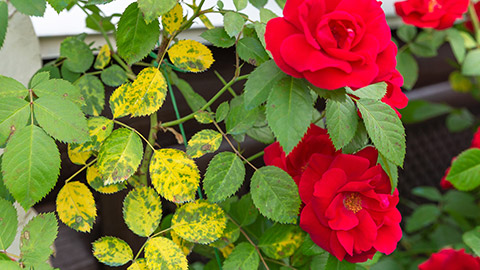
Daltons.co.nzBlack spot is one of the most prevalent fungal diseases on roses in New Zealand. It must be prevented as once it is in the leaves it cannot be cured and will spread very quickly.
As mentioned earlier, a plant disease is the damage caused to a plant by a pathogen. In some cases there is only one species of pathogen that causes the plant disease, but in other cases many different pathogens can lead to the same disease (plant damage). In this sense, it is not always possible to list the pathogen(s) that cause the plant disease.
Some plant diseases that commonly occur in Aotearoa are described below.
Blight
![[ADD IMAGE'S ALT TEXT]](/sites/default/files/late%20blight.jpg)
Blight is a rapid and complete chlorosis, browning, then death of plant tissues such as leaves, branches, twigs, or floral organs. Accordingly, many diseases that primarily exhibit this symptom are called blights.
Chlorosis is a condition where leaves don’t produce enough chlorophyll – they turn pale, yellow, or yellow-white – which means the plant can’t produce enough energy and may die as a result.
Examples of blight include:
| Potato blight (2 types) | Late blight (commonly called potato blight) is caused by the fungus-like microorganism Phytophthora infestans. It produces “dark green, then brown then black spots on the surface of potato leaves and stems, often near the tips or edges, where water or dew collects." Wikipedia contributors | 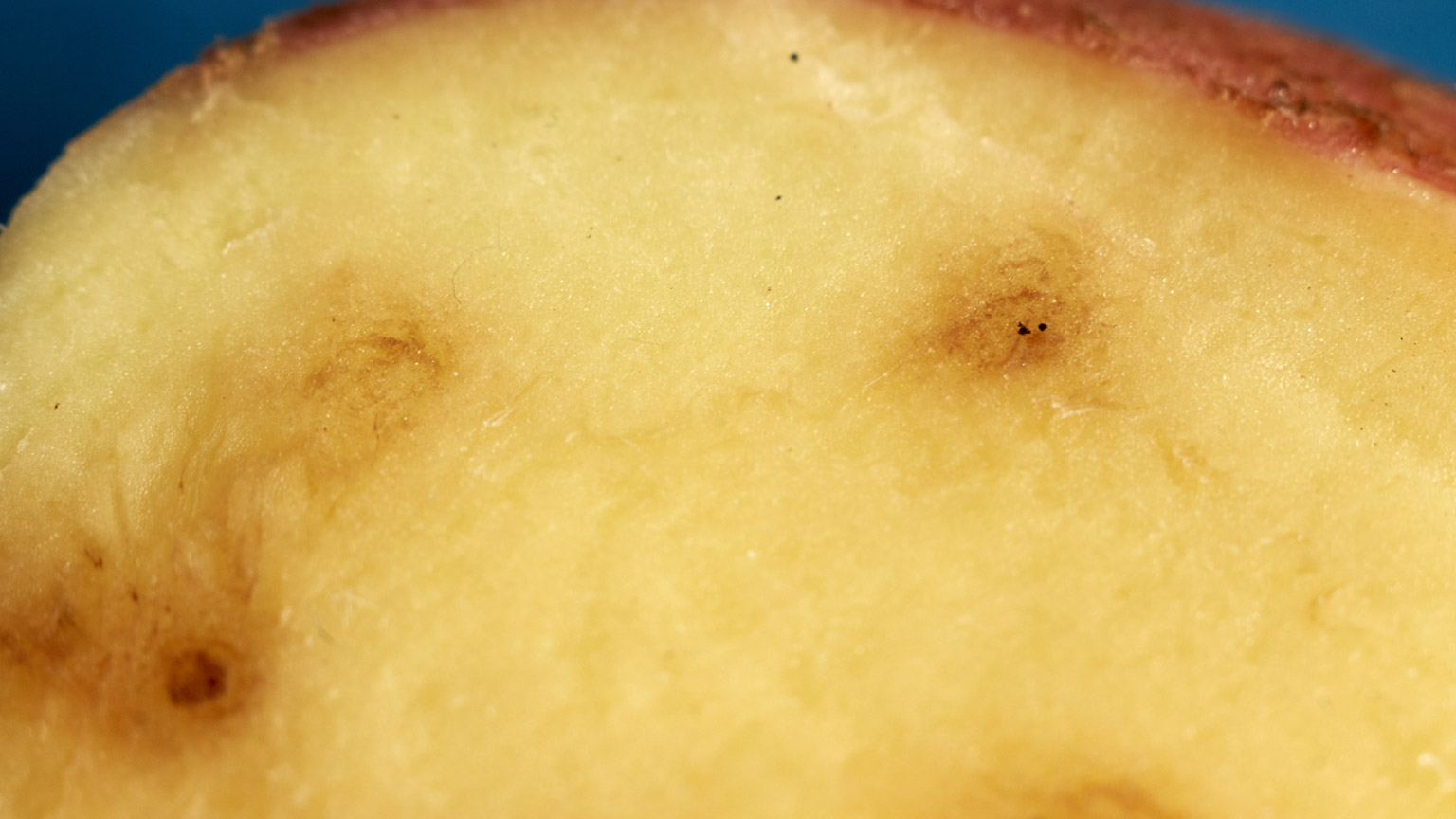 The image above shows the leaves, and this shows the potato infected with late blight. The entire potato will eventually rot underground. |
| Early blight (sometimes also called potato blight), which is caused by the fungal pathogen Alternaria solani and affects both potatoes and tomatoes. It presents as a bullseye pattern of brown spots on leaves and fruit | 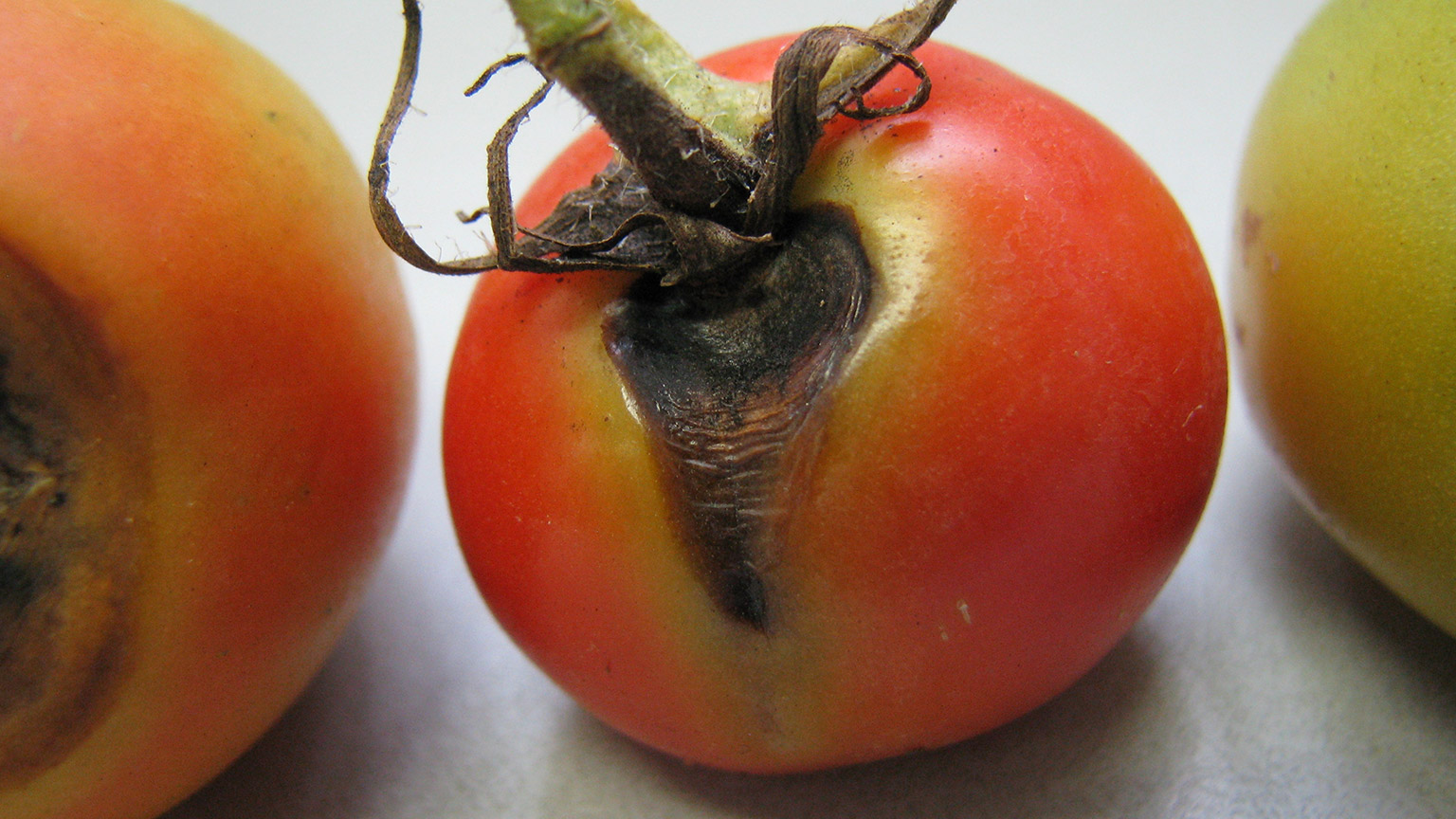 This tomato is infected with early blight. The leaves would also have brown spots. |
|
| Leaf blight | This is caused by Pseudomonas marginalis pv. marginalis. It primarily affects lettuces. |  The heart of this lettuce plant shows signs of leaf blight. |
| Fire blight |
Also written fireblight, this is a contagious disease affecting apples, pears, and some other members of the family Rosaceae. It is a serious concern to apple and pear producers. Under optimal conditions, it can destroy an entire orchard in a single growing season. The causal pathogen is Erwinia amylovora Symptoms to look for, for this severely damaging disease can be found on Wikipedia: Fire blight/Symptoms |
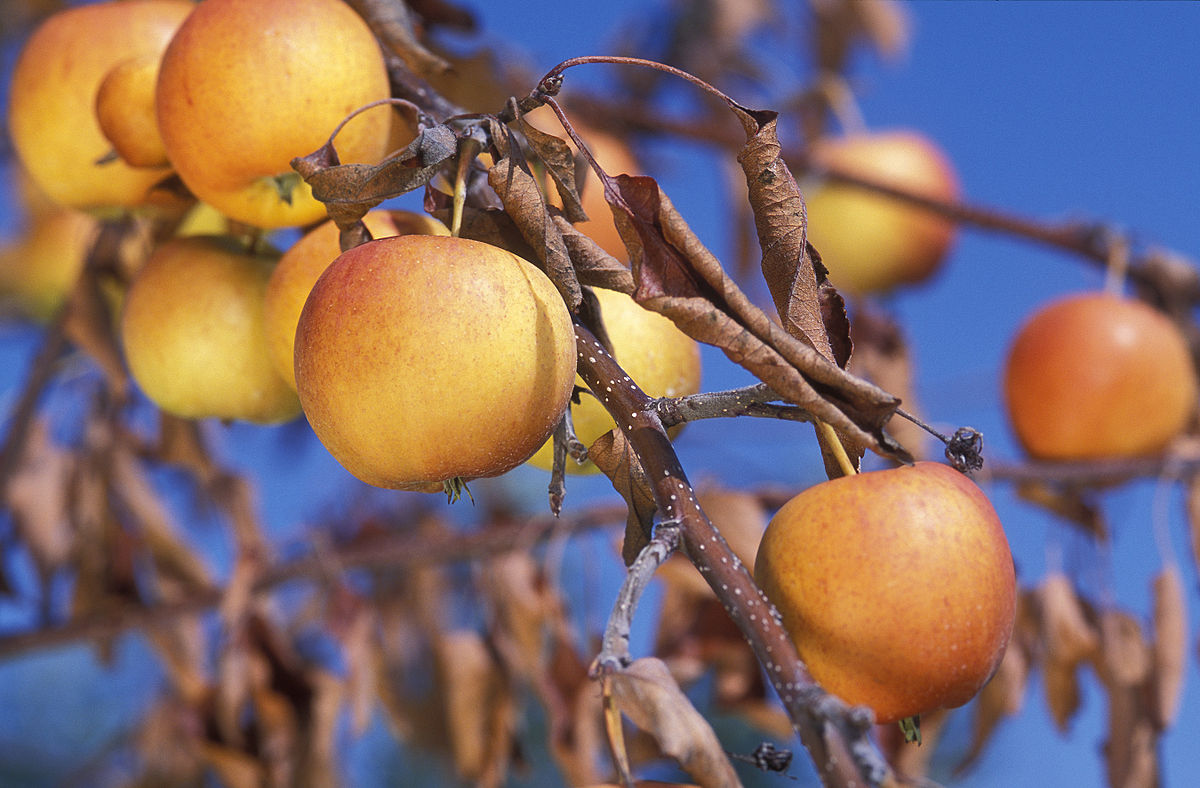 Gala apple branch with “scorched” leaves after a severe fire-blight infection. |
Bitter rot
![[ADD IMAGE'S ALT TEXT]](/sites/default/files/Bitter%20Rot.jpg)
Bitter rot on apple and pear fruit is a fungal disease most commonly caused by the fungi Colletotrichum gloeosporioides (also known as Glomerella cingulata) or C. acutatum.
The following description of bitter rot is from the Pennsylvania State University College of Agricultural Sciences, and revised into metric measurements and southern hemisphere seasons:
Symptoms
Bitter rot occurs only on fruit. Cankers can form on twigs, but they are rare. The fungus is one of the few fruit rot organisms that can penetrate the unbroken skin of the fruit. When the spore penetrates the skin, the infection will then go dormant (quiescent phase) for a period of time. During this time, the spore does not grow and is not susceptible to fungicides. Consequently, fungicides need to be applied prior to the initial infection of the spore.
Maturity of the fruit, temperature, humidity, and presence of disease are factors that determine when the quiescent period ends and the disease symptoms manifest. Bitter rot typically manifests in January and February, and fruit susceptibility increases as it begins to mature.
The disease is noticed first as a small, light brown, circular spot. One or many spots may appear; if temperature and humidity are high, they enlarge quite rapidly and soon change to a dark brown. By the time the spots are 3-6mm in diameter, they are distinctly sunken, or saucer-shaped. When they reach 12mm in diameter, small black dots, the fruiting bodies of the fungus, appear in the sunken lesion. These may be arranged in concentric rings. Later, they ooze a gelatinous, salmon-pink mass of spores, washed by rains to other fruit.
When cutting through the lesion on the horizontal axis of the apple, the flesh is light brown and watery in a cone-shaped area, with the small end of the cone toward the fruit centre. As the fruit ripens, it decays rapidly and finally shrivels into a mummy.
Disease cycle
Bitter rot spores are suspected to overwinter in buds, mummified fruit, cracks and crevices in the bark, and cankers produced by either the bitter rot fungus or other diseases. Spores have been detected as early as green tip, with the highest numbers of spores produced during warm weather. Spores are washed by rains to developing fruit. The optimal conditions for the disease to develop are surface wetness and a temperature of 21-32°C. Frequent rain events, which lead to extensive wetness hours combined with warm temperatures, have resulted in significant bitter rot outbreaks. Apples are susceptible to infection throughout the growing season, but they seem to be slightly more susceptible during the latter half of the season… at least in part because that is when temperatures are the highest.
Black spot
![[ADD IMAGE'S ALT TEXT]](/sites/default/files/Black%20Spot.png)
Black spot, also called rose black spot is one of the most prevalent fungal diseases on roses in New Zealand… Some rose varieties are almost immune to black spot, while others are exceptionally susceptible. Climatic conditions have a large influence on the appearance and severity of infection, ie. the warmer humid midsummer months are a haven for black spot.
Black spot is caused by the fungus Diplocarpon rosae.
Signs of black spot on roses
Black spot can be distinguished from other leaf spot diseases by its fringed edges and dark black colour. Raised, brown, black, reddish-purple spots with fringed edges may also appear on rose canes. Warm, humid conditions favour its germination and growth. Over time leaves will yellow and drop off. If left unchecked, it can cause a rose bush to totally defoliate.
Citrus scab
![[ADD IMAGE'S ALT TEXT]](/sites/default/files/Citrus%20Scab.png)
Citrus scab (verrucosis) is a fungal disease caused by the fungus Elsinoë fawcettii and Elsinoë austealis. It “causes raised warty lesions to appear on fruit and leaves, often causing the leaves to buckle. While the disease doesn’t cause major problems it should still be treated as it negatively affects the health and vigour of the tree, making trees more susceptible to other problems.
Fruit is still edible, though less attractive.
Spores of the fungus are spread during wet weather and are dispersed by rain splash and wind. They live in the corky growths on the fruit and leaves, fruit remain susceptible for up to 3 months after petal fall.
Citrus scab commonly presents when the weather is cool and wet. The disease infects fruit when they are young.
Rust
![[ADD IMAGE'S ALT TEXT]](/sites/default/files/Rust.png)
We can look to the pathogenic fungi of the order Pucciniales for the cause of rust plant diseases. These specialized plant pathogens have some unique features. On the whole, there are many types of rust fungi, and they affect a large range of plants. However, each species targets specific hosts and do not transmit fungi to non-host plants.
Source: Wikipedia contributors.Rust spores are commonly spread by wind, water or insects. The spores generally germinate on plant surfaces and form a structure called a germ tube that hunts for a stoma through which to enter the plant and infect it.
The Royal Horticultural Society website describes the symptoms (signs) of rust as follows:
- Pale leaf spots eventually develop into spore-producing structures called pustules
- The pustules are found most commonly on the lower leaf surface and produce huge numbers of microscopic spores
- Pustules can be orange, yellow, brown, black or white. Some are a rusty brown colour, giving the disease its common name
- In some cases there may be dozens of pustules on a single leaf
- Severely affected leaves often turn yellow and fall prematurely
- Pustules also sometimes form on leaf stalks (petioles), stems and, rarely, on flowers and fruit
- Heavy infection often reduces the vigour of the plant. In extreme cases (e.g. with antirrhinum rust) the plant can be killed.
